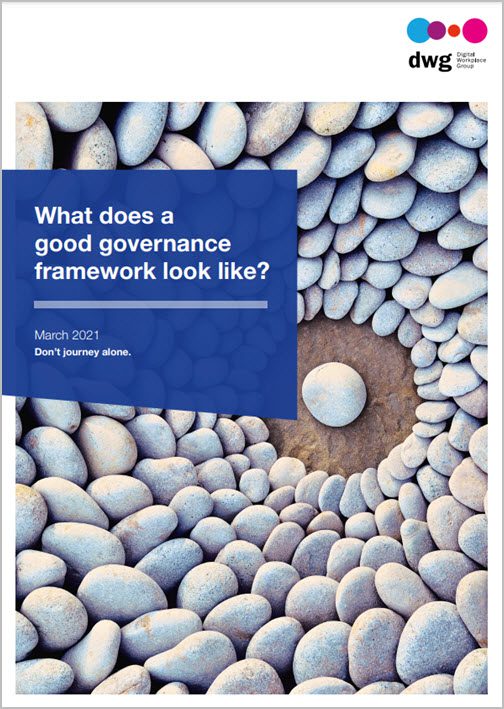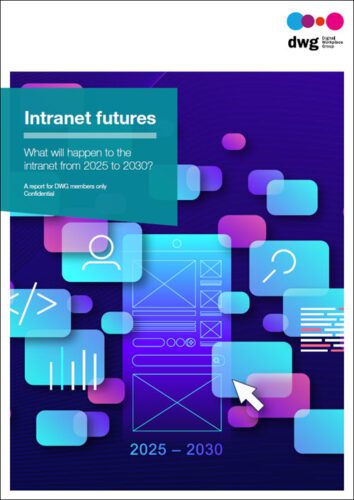Why robust information management is critical for digital workplace governance
Information management (IM) comprises an important set of disciplines and activities – and yet, while it often gets mentioned in passing, it doesn’t always attract the attention (and investment) it deserves. As we rely more on the digital workplace, the need for strong governance becomes increasingly clear. Here, robust information management activities, such as having an enterprise taxonomy, are proving to be highly valuable in supporting sustainable and high-performing digital workplaces.
In this post we’re going to explore what information management and digital workplace governance actually are, and look at the contribution information management can make to the digital workplace.
What is digital workplace governance?
The digital workplace can be defined as the set of technologies, tools and applications that are provided for employees to carry out their work. An effective digital workplace, with a consistent and coherent experience that enables employees to succeed in their role and get things done, requires governance to be in place.
Digital workplace governance can be defined as the set of policies, processes, controls, rules, roles, structures and guidelines that are in place to help make the digital workplace work every day and be successful.
What is information management?
The Association for Intelligent Information Management (AIIM) defines information management as: “managing information through the information lifecycle regardless of source or format… for delivery through multiple channels” and says that “the focus of IM is the ability to capture, manage, preserve, store and deliver the right information to the right people at the right time”.
This definition is quite far-reaching and has overlap with areas such as enterprise content management, records management, knowledge management (KM), document management, taxonomy and metadata management, and more. Central to successful IM is also having consistent policies, processes and standards that are defined and applied throughout the organization.
Sometimes the definitions of areas like IM and its differentiation from areas such as KM and data governance can cause quite a lot of debate; while these distinctions are interesting, they can boil down to semantics and, in practice, in order to work successfully an area like knowledge management requires information management practices anyway.
Information management in the digital workplace
There are several areas of the digital workplace where underlying governance requires robust information management. Let’s explore seven of these key areas.
1. Personalization and content targeting
Personalization is now a critical element of many digital workplace tools and channels, for example enabling content targeting and more personalized experiences on intranets. In large and complex global organizations, personalization can help to ensure the relevance of digital channels across highly diverse workforces, who may need to view particular content based on their role, location, division, level of hierarchy, and even period of tenure.
Effective personalization usually relies on accurate and complete employee profile data – for example, stored in Active Directory (AD). But maintaining up-to-date profile data is more challenging than it may seem and can require data manipulation, clear ownership of different groups, data governance, and ongoing management. Information management approaches will almost certainly need to be applied to employee data in order to enable effective personalization throughout the digital workplace.
2. Findability and search
Findability is a key challenge across the digital workplace as well as its constituent tools and channels; how do we ensure that employees can find what they need, not only via the navigation but also through searching? Here, IM plays a critical role in ensuring there is a consistent and user-focused approach to findability through:
- having an enterprise taxonomy that ensures a consistent and user-focused approach to tagging and labelling, which spans across multiple systems such as the intranet but also in core management platforms too
- ensuring there are approaches for ongoing taxonomy (and related ontology) management so that the taxonomy continues to meet organizational and user needs
- defining and applying a metadata and tagging strategy and standards that align with the taxonomy and help ensure findability.
There are additional processes and activities that need to be carried out too in order to support good findability, including change management, training, user testing, managing the search experience, and more.
3. Security and data privacy
Security and data privacy across the digital workplace are critical for obvious reasons, and organizations take these aspects very seriously, particularly with the rise of hybrid working and the scaling up of digital activity. Here, robust information management is needed to ensure that all the content and data in different systems meet regulatory and compliance needs, and that there is clarity for employees in knowing what information can be posted where and into which applications. For digital workplace teams, having clarity over what content and documents can go into the intranet or need to be posted into other more private channels, such as Teams, is also key to maintaining the integrity of different tools, channels and applications.
IM activities start with defining security policies and processes, then ensuring there is effective metadata that matches security and privacy classifications of content. There can also be considerable operational detail, such as defining sensitive stop words and data formats that systems like Yammer and Teams can detect in order to identity any potential compliance breaches; this is an area where we can expect ongoing IM to make a contribution as more products also produce features that help to monitor activity to reduce risks.
4. Data governance
Robust data governance is increasingly becoming an important activity in the digital workplace, particularly as environments become more complex and systems need to work together. The increasing use of data for analytics and reporting also necessitates governance to ensure standardization and integrity.
Typically, data governance needs to ensure that data can work together effectively by bringing it together, feeding it from one system to another, making sure it is in the right format for reporting and comparison, and more. This will involve defining policies around governance to make sure the data is secure, but also then going into the fine detail to ensure that data can be standardized. There are also likely to be additional areas around data governance, such as establishing clear ownership of different data sets, standards for data visualization, and more.
5. Knowledge management
Knowledge management is an important activity in organizations, which powers a core set of processes within the digital workplace. Expertise location, Communities of Practice, enterprise search, managing access to project information, and effective collaboration often come under the KM umbrella, and usually require some core information management approaches to be effective. For example, expertise location and surfacing project data usually rely on an enterprise taxonomy as well as underlying information polices to make them happen.
6. AI and machine learning
Another area where KM teams are getting involved is in enabling artificial intelligence (AI) and machine learning (ML), which are starting to become more prevalent across the digital workplace in different products and features such as chatbots. As we established in our DWG member research report on AI and automation, underlying governance is a critical enabler of AI in the digital workplace. Process standardization, data standardization, metadata management, data governance, taxonomy management, and more, usually need to be in place in order to get the best out of AI; there can also be the need to ‘train’ systems with ML, requiring IM approaches.
AI and ML tend not to be ‘plug and play’ but require the right foundational work to be sustainable and drive value; much of that foundational work is rooted in information management.
7. Records management and document management
Records and document management is perhaps not as glamorous as cutting-edge AI, but is also very important from compliance, operational and strategic perspectives. There are various regulatory, legal and compliance related factors that organizations must follow in how they manage content and records across the lifecycle, and they may need to be able to access and search documents and records. Operationally, employees must be able to access certain documents such as policies and procedures and these need to be tightly controlled to ensure that they can view the latest version. Strategically, making sure employees have access to the right content at the right time is key. IM approaches and digital workplace governance are the backbone of successful document and records management that supports all these needs.
Digital workplace governance and information management are there to help
Successful digital workplaces require a lot of work behind the scenes in order to be effective. While much attention is given to the required change management effort, you also need to have information management and digital workplace governance in place for everything to work smoothly. As we rely more and more on AI-driven, intelligent digital workplaces that are becoming progressively more complex, the need for robust information management is only set to increase.
Related resources
What does a good governance framework look like?
Download the full report
How should we use artificial intelligence in the digital workplace?
Download the full report
Communications and Content:
DWG Annual Update
Download the report excerpt
Digital workplace content strategy:
What practitioners need to know
Download the report excerpt
Categorised in: Digital workplace




